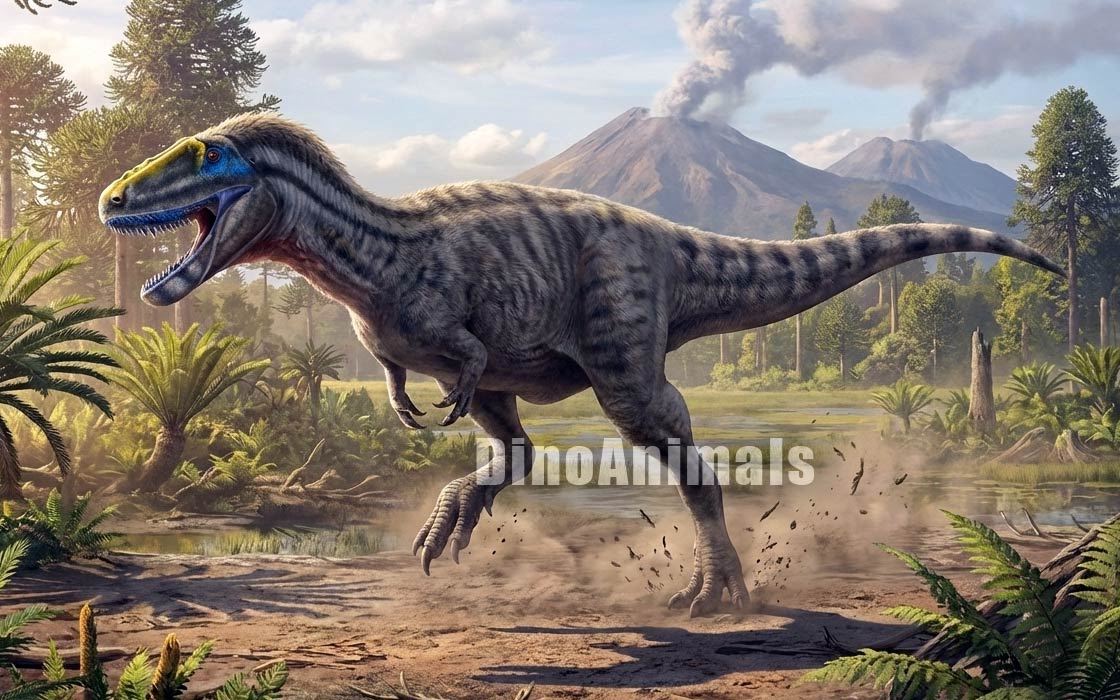Every month, 100,000 readers use the Dinosaur Database, but we receive no support from you. Developing and updating the database requires a lot of work. If you want it to remain open and be updated, please support us via the "Buy us a coffee" button available on every page or via the Support page.
Dinosaur: Asiatyrannus xui

| Length*: | 4.2 m | 13.8 ft |
| Weight*: | 300 kg | 661 lb |
*The largest known specimen
Period
Epoch: Late Cretaceous
Stage: Maastrichtian
Years: 67-66 Ma
Details
Status: valid
Author: Zheng et al.
Year: 2024
Distribution
Area: Asia
Country: China
Region: Jiangxi
Formation: Nanxiong
Description
Asiatyrannus xui
Asiatyrannus xui is a newly discovered deep-snouted tyrannosaurid theropod from the Upper Cretaceous, specifically the Maastrichtian stage (approximately 67-66 million years ago). Found in the Nanxiong Formation of southeastern China, it provides important insights into the diversity of tyrannosaurs in Asia. The genus name Asiatyrannus references its Asian origin and the Latin word for “tyrant,” while the species name xui honors Dr. Xing Xu, a leading paleontologist who has made significant contributions to the study of Chinese dinosaurs.
Physical Characteristics
Asiatyrannus xui is a small to medium-sized tyrannosaurid, with an estimated total body length of 3.5 to 4 meters (11.5 to 13 feet). The skull, measuring 47.5 cm (18.7 inches) in length, is deeper and more robust than those of long-snouted tyrannosaurs like Qianzhousaurus. The holotype specimen includes a nearly complete skull and partial postcranial skeleton, including parts of the caudal vertebrae, femur, tibia, and fibula. Its deep, robust skull and well-developed nasal protuberances suggest it was a formidable predator, adapted to a different feeding strategy compared to its sympatric relative Qianzhousaurus, which had a longer, more gracile snout.
One of the unique features of Asiatyrannus is the presence of two small, deep fossae located on the lateral surface of the premaxilla, a characteristic not observed in other tyrannosaurs. The maxilla is proportionally deeper than in most other tyrannosaurids, and the postorbital bar is slender and straight, with parallel margins. The nasal bones are fused and exhibit pronounced vaulting, similar to the larger-bodied tyrannosaurs like Tarbosaurus and Tyrannosaurus.
Diet and Feeding Habits
As a carnivorous theropod, Asiatyrannus xui was likely a top predator in its environment. Its robust, deep skull and strong jaw muscles suggest that it was adapted to delivering powerful bites, likely targeting large herbivorous dinosaurs that coexisted with it. The deeper snout indicates a different ecological niche compared to the long-snouted Qianzhousaurus, suggesting that these two tyrannosaurids had distinct feeding strategies to avoid direct competition.
The teeth of Asiatyrannus were typical of tyrannosaurs, with serrated edges designed for slicing through flesh. Its powerful hindlimbs and muscular build would have allowed it to pursue and overpower prey, making it an effective predator in its ecosystem.
Habitat and Distribution
The fossils of Asiatyrannus xui were discovered in the Nanxiong Formation in Ganzhou City, Jiangxi Province, China. This region, during the Late Cretaceous, was characterized by a warm, subtropical environment with rich vegetation and a variety of dinosaur species. The formation is known for its abundance of dinosaur fossils, particularly oviraptorosaurs, and it has yielded some of the most diverse Late Cretaceous faunal assemblages in southern China.
Asiatyrannus lived in sympatry with the long-snouted tyrannosaurid Qianzhousaurus, as well as various herbivorous dinosaurs. This coexistence of different tyrannosaur species within the same region suggests a complex ecosystem where each species occupied a distinct ecological niche.
Behavior and Social Structure
Direct evidence of the behavior of Asiatyrannus is limited, but like other tyrannosaurids, it was likely a solitary hunter. Its robust skull and strong jaws indicate it was capable of tackling large prey on its own. However, the presence of sympatric tyrannosaurids like Qianzhousaurus suggests that Asiatyrannus may have engaged in interspecific competition for resources.
The well-developed nasal protuberances and deep skull may have also played a role in visual displays or combat with rivals. As a relatively small-bodied tyrannosaur, Asiatyrannus likely filled a different ecological role compared to the larger tyrannosaurids found in other parts of Asia, such as Tarbosaurus and Zhuchengtyrannus.
Discovery and Research
The holotype specimen of Asiatyrannus xui (ZMNH M30360) was discovered at a construction site in Shahe Town, Nankang District, Ganzhou City, in southeastern China. The fossils were prepared by technicians at the Zhejiang Museum of Natural History, where the specimen is now housed. This discovery represents the first definitive deep-snouted tyrannosaurid from southern China and is notable for its relatively small size compared to other Late Cretaceous tyrannosaurids.
Histological analysis of the bones suggests that the holotype of Asiatyrannus was a sub-adult, at least 13 years old, but still growing at the time of death. The periosteal bone shows signs of active growth, and the presence of multiple lines of arrested growth (LAGs) indicates that Asiatyrannus had experienced a period of rapid growth earlier in its life, similar to other tyrannosaurids.
Significance and Interesting Facts
Asiatyrannus xui is significant because it represents the southernmost occurrence of a deep-snouted tyrannosaurid in Asia and provides evidence of the diversity of tyrannosaurs in the Late Cretaceous. Its discovery highlights the coexistence of multiple tyrannosaurid species with different skull morphologies and body sizes, suggesting that they occupied different ecological niches within the same environment.
An interesting aspect of Asiatyrannus is its deep skull, which contrasts with the long, gracile skulls of other tyrannosaurs like Qianzhousaurus. This difference in skull morphology indicates that Asiatyrannus likely had a different feeding strategy, perhaps focusing on different prey or employing a different hunting style.
Locations
Sources
Material: Nearly complete skull and partial disarticulated postcranial skeleton.
References: Zheng, W.; Jin, X.; Xie, J.; Du, T. (2024). "The first deep-snouted tyrannosaur from Upper Cretaceous Ganzhou City of southeastern China".




